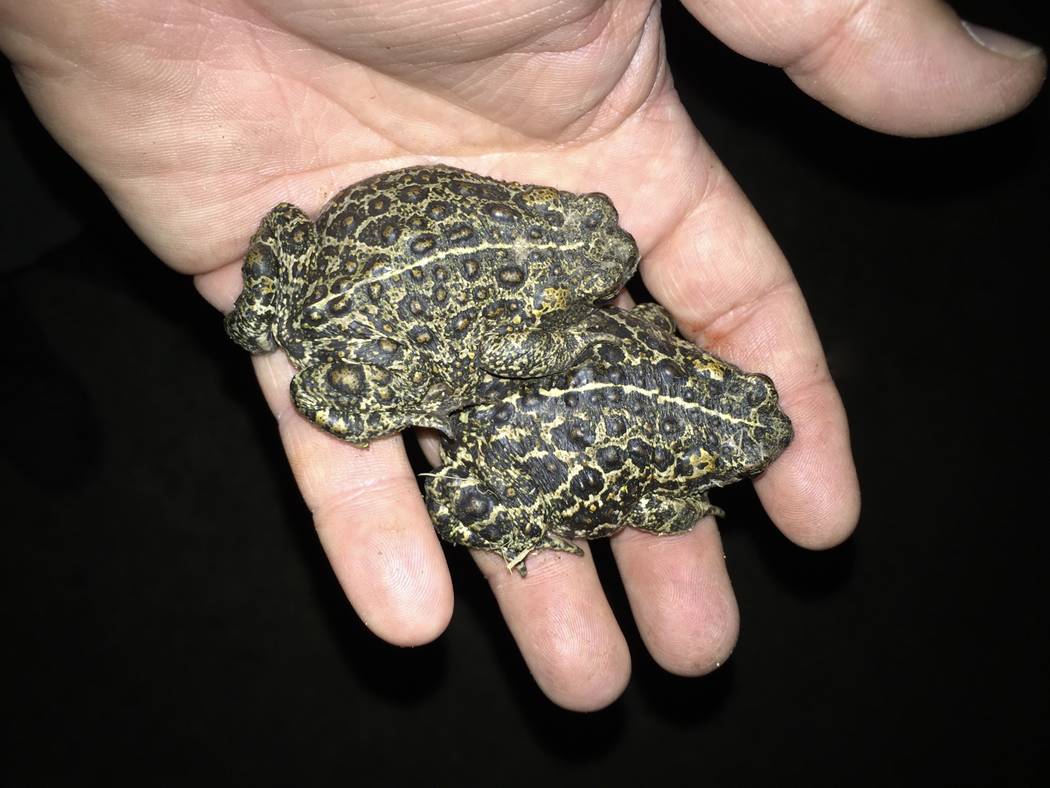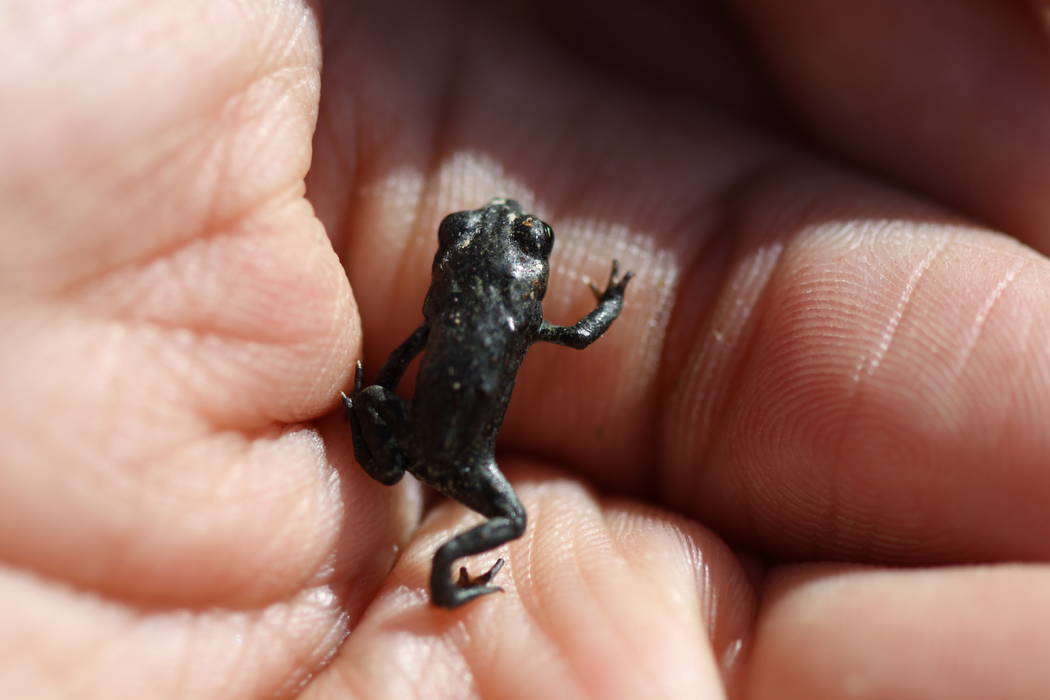Newly discovered toad species in Nevada already under threat
Nevada researchers just identified the first new species of toad found anywhere in the U.S. in 50 years, and the race is already on to save it from extinction.
Conservationists are preparing an emergency petition to have the Dixie Valley toad listed as an endangered species to protect it from a proposed geothermal energy project at the edge of its isolated home in Churchill County.
The toads are about 2 inches long with bumpy skin mottled in green, black and brown. Their only known habitat is a spring-fed marsh covering just more than 2 square miles of federal land in the remote Dixie Valley, about 400 miles northwest of Las Vegas.
The new species was discovered by University of Nevada, Reno, researcher Michelle Gordon, former UNR researcher Eric Simandle and UNR Professor C. Richard Tracy, a renowned biologist who has a species of lizard named after him in Argentina.
Gordon said the unique toad first caught the eye of scientists in the early 2000s. A follow-up study launched in 2014 confirmed its status as a genetically distinct species.
The peer-reviewed scientific journal Zootaxa published Gordon and company’s description of the animal July 6. In the article, the researchers refer to it as “a diamond in the rough desert scrublands of the Great Basin.”
There are a few physical characteristics that set the toad apart from its closest relatives, the ubiquitous Western toad and its less-common cousins, the Deep Springs and Yosemite toads of California and the Amargosa toad of Southern Nevada.
In addition to its distinctive coloring, the Dixie Valley toad is roughly half the size of a full grown Western, and it has poison glands on its back legs that are not found on other toads in the region, Gordon said.
“They’re very pretty toads,” she said. “They look just like the riparian vegetation they live in. They’re perfectly adapted to their environment.”
Not easy being green
That environment could be about to change.
The Bureau of Land Management is currently reviewing a plan by Reno-based Ormat Technologies to build up to two 30-megawatt geothermal power plants directly adjacent to the toad’s habitat.
The project also would include as many as 15 production and injection wells, a network of pipelines and access roads and a transmission line stretching 48 miles to Ormat’s existing, 22-megawatt Jersey Valley Geothermal Power Plant, which supplies power to NV Energy.
Paul Thomsen, Ormat’s executive director for government and regulatory affairs, said in a written statement that his company is “committed to developing its renewable, geothermal facilities in the most environmentally friendly way possible, and we look forward to meeting the requirements put forward by the Bureau of Land Management.”
Gordon and others insist the project poses too great a risk to North America’s newest toad.
Patrick Donnelly is Nevada wildlife advocate for the Center for Biological Diversity, a national environmental group based in Tucson, Arizona.
He said his organization generally supports renewable energy development, but this is simply not the right place for such a project.
Project still under review
Others have raised similar concerns.
During last month’s public comment period on the assessment, the Nevada Department of Wildlife questioned Ormat’s plans to route the power lines from the new plants through the heart of the wetland.
The Fallon Paiute-Shoshone Tribe objected to industrial development in or near what it called a “sacred place of healing” and the last intact springs available in the area for tribal use.
Donnelly said the environmental assessment, which was written before the new species was confirmed, underestimates the potential threats to the toad and the springs that sustain it. The agency’s stance seems to be “there won’t be any impacts, and if there are we will detect them and fix them,” Donnelly said, adding that even a small disruption could prove irreversible.
“If those springs went dry for even one year, that would be the extinction of the species,” he said.
The BLM is reviewing the comments it received on the environmental assessment as it prepares to render a decision on the geothermal project.
Ken Collum, manager of the bureau’s Stillwater field office, said the toad was considered in the assessment along with other sensitive wildlife in the area. He said the toad’s new status as a distinct species won’t require any additional scrutiny of Ormat’s plans, but an endangered species listing almost certainly would.
Collum couldn’t say when the BLM will announce its decision.
The stakes couldn’t be higher as far as Gordon is concerned.
“The toad doesn’t have anyplace else to go,” she said. “It could be gone before we can find out more about it.”
Contact Henry Brean at hbrean@reviewjournal.com or 702-383-0350. Follow @RefriedBrean on Twitter.
Forever tied to a toad
Nevada's newest species of amphibian is the Dixie Valley toad, but in scientific circles it will be known by the Latin name Bufo (Anaxyrus) williamsi.
Reno retiree Bob Williams is the williamsi in question.
Researchers from the University of Nevada, Reno, said they decided to name their new discovery after Williams because of his years of support for the school's biodiversity program.
"I was actually very honored," Williams said. "They're really pretty toads. I just think they're cool."
Williams served as Nevada supervisor for the U.S. Fish and Wildlife Service from 1997 until his retirement in 2011, and throughout that time he forged a strong relationship between the agency and UNR. Some of the work that led to the discovery of the Dixie Valley toad was funded by the Fish and Wildlife Service.
Williams has seen the Bufo (Anaxyrus) williamsi in person both in the lab and in the field. "I've actually held one," he said with obvious pride.
He has since joined the effort to protect the species that bears his name, most recently by signing on to a letter from the environmental group Center for Biological Diversity protesting plans for a geothermal energy development next to the toad's isolated habitat.
"I always thought the unique, small species were as important as the wolves and the grizzly bears," he said.

























